August 7 - 13, 2016: Issue 275
Peter Rumble
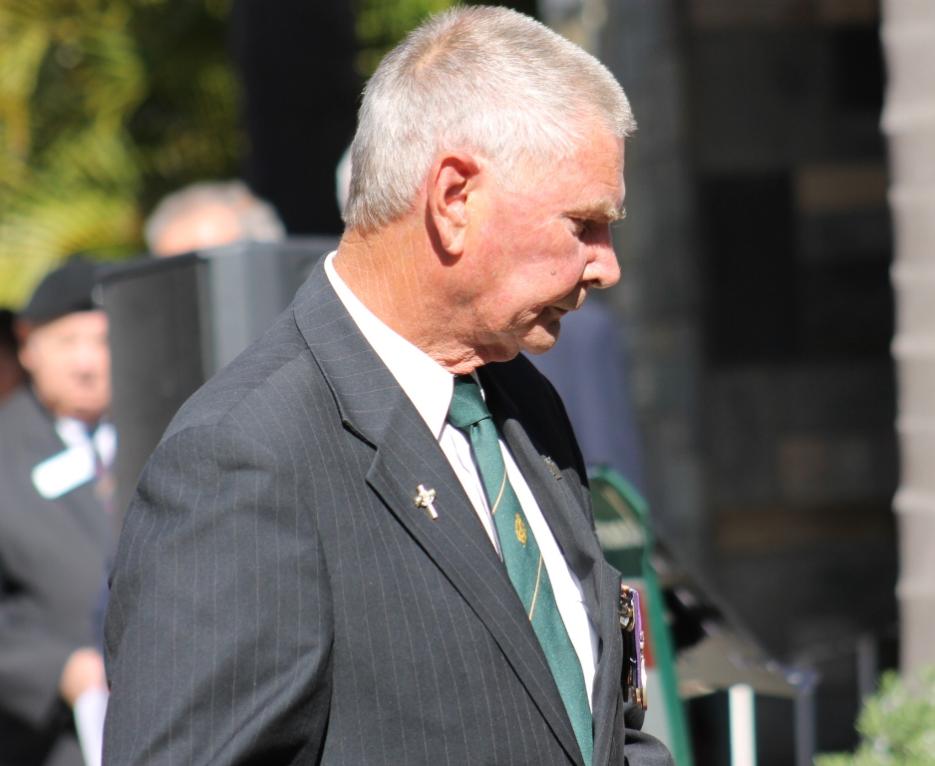
"Character is not made in a crisis it is only exhibited."
Robert Freeman
This year the 50th Anniversary of the Battle of Long Tan will be commemorated at Vietnam Veterans Services around Australia on Thursday, August 18th. Vietnam Veterans day was originally known as Long Tan Day, chosen to commemorate the men of D Company, 6RAR who fought in the battle of Long Tan in 1966. Vietnam Veterans (Northern) will also hold their Commemoration Service again this year at Palm Beach RSL (Club Palm Beach) with the Muster to take place around 10.30 a.m. at Palm Beach Ferry Wharf prior to the March to the club and 11.00 a.m. Service.
On February 17th 2017 Peter Rumble, along with fellow members of the 6RAR, will be meeting on Bribie Island for their own 50th Anniversary of commemoration - that of Operation Bribie, February 17, 1967. Pete was a member of 5 Platoon, B Company, 6RAR, and one of three men wounded while three of his mates were killed beside him. Overall Operation Bribie lost eight men of 6RAR, killed in action, while a further 27 were wounded.
5th platoon was the most highly decorated platoon with two Military Medals and three mentioned in despatches.
This week we spoke to Peter, current President of Vietnam Veterans (Northern) to catch up after a Profile run in 2012 and ask how he feels 50 years on, if some kind of healing has taken place on the eve of the 50th Anniversary of Bribie and Vietnam Veterans Day 2016.
" I must admit if you had asked me even a few years ago if I thought I'd be celebrating the 50th anniversary of Bribie my answer would be I didn't think so, that it wouldn't happen."
"I remember I didn't feel that bad the first few years after coming back, setting aside what I went through on coming home. I married, had children, was busy, got on with life.
During the late 1990's I started to feel it. My wife explained she couldn't stay with me any longer and that kind of tipped me over the edge.
I was referred to one psychiatrist who was hopeless. Then they put me onto another, a Vietnam Veterans Specialist, and he was great. At the beginning of every year I still make an appointment so see him each month but if I don't turn up he doesn't worry so much, he knows I'm past the worst of it. I explained just recently I wouldn't be at our next month's appointment as I was going to Samoa with mates and he said 'can I come with you?'.." (laughs).
A man defines himself by how he is in a crisis, his essential nature is plain and plain to see. Australian country men have long been the backbone of this place, their matter of fact approach to all circumstances, their innate honesty and mateship have been the stuff of legends and the subject of many stories since the inception of Australia itself. Their attendance to helping others, their clear love of sky, water and land, the way everything is just 'got on with' communicates an integrity that will not perish. Add to this a lifelong love of, in Pete's case, swimming, of loyalty to mates in danger whether physical, emotional or mindful, and caring about other's and you begin to garner a glimpse into Peter Rumble's path.
Donald 'Peter' Rumble is a man with character. Known for his brilliant smile, self-deprecation and quiet manner outside of boisterous moments, this gent is also part of history in being one of the survivors of Operation Bribie.
It didn't begin, or end, there though... this Warriewood gentleman is a country boy:
I was born in Griffith NSW on the 3rd of July, 1945. We left Griffith when I was about 5. My dad and mum bought a shop from his brother who had gone bust in Grenfell. I grew up in Grenfell, went to Grenfell Public school (Henry Lawson's school); a typical country town, with every sport available. You name it, I played it; football, hockey, swimming.
How good were you at swimming?
I think I still hold the record for the most number of points scored at an annual carnival. Probably because I won every event in my age group and also came second in the open diving.
What did you do when you left school?
I joined the local accountancy program but was having trouble doing my studies because there was just too much sport to play. I was about 17 or 18 at this time. After 18 months but then one of the partners, Lionel, had a chat to my dad and told him that basically he could make money out of me until I was about 30 odd, by just writing up the books and doing the balancing and so on but after that, I wouldn’t be making any money for them. He suggested that I would be better off if I found another form of employment.
So what did you do after that ?
I went down to Canberra. My elder brother was down there, so I went to stay at the same place he was boarding at. I joined the Public Service in the Department of Navy but I got sick of spending all my wages in the canteen. I was working in a filing division and there was bugger all to do, so to pass the time of time you’d go and have a sleep in the file room or you’d go and have something to eat, or coffee, and this was getting to me. So I decided to look around for another job and managed to get a job with a finance company in Canberra.
I think the only reason I got the other job was because there was a fellow there with the same surname. The guy who was the office manager had this thing about names and if someone had the same or a similar name he immediately jumped on it.
How did you end up involved in the Vietnam War?
I was called up early 1966. I had to register on my 20th birthday in 1965 and I got notification about late December 1965 that I was being called up in in the Army Unit for March 1966.
How old were you then ?
Just shy of 21.
Where did they send you for training?
Kapooka. This was Basic Training; they’d get these little blokes about three foot tall who were usually Scottish and who would march you around and round and round the Parade Ground, swearing and carrying on, treat you like dirt and telling you if you didn’t do the right thing they’d shit on you from a great height, which would make you laugh and then you’d get into strife for that too.
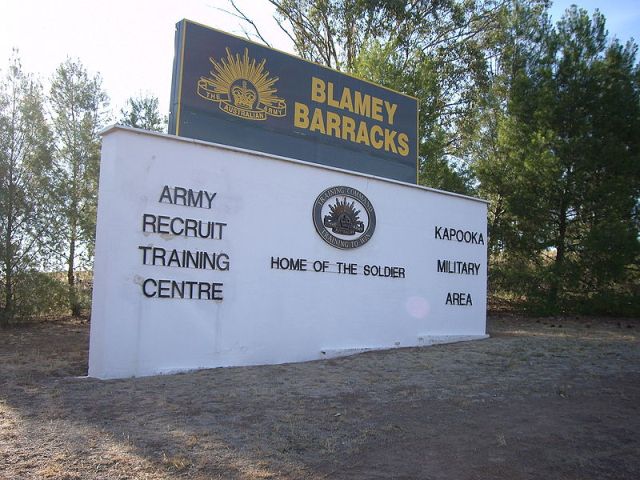
Right: Kapooka (near Wagga Wagga) , courtesy Virtual Steve.
I eventually went to Infantry Training at Singleton. It was while we were halfway through our infantry training that Long Tan happened in August ’66 and they were searching for about 40 volunteers to immediately go through the Jungle Training Centre and then go over as reinforcements and make up the numbers that were lost in Long Tan.
So we pulled out of infantry training early and went to Canungra and did Jungle Training at their course there. We then came back to Sydney to their Infantry Centre at Ingleburn but couldn’t get to Vietnam because Qantas were having an Air Strike and that was the only way of getting over there quickly. Eventually, in December ’66 they found an American starlifter that was bringing home troops from Borneo, and they shoved us all on that and sent us over to Vietnam.
We landed at Tan Son Nhat. We were posted to the 1st Australian Reinforcement Unit in NuiDat, the Australian Task Force Base. From there you were allocated to a unit. They would come along and say, ‘look we need some guys for %RAR, anyone want to put their hand up’ and a couple of guys would say, ‘look I know someone there. I’ll go.’ Then; ‘we need some guys for 6RAR.
I knew a guy from when I was growing up in Grenfell, he was in Temora, and we used to play football against each other, and swim against each other and we became good mates. I knew he was in 6RAR in B Company, so I went there, and they asked if there was any company I preferred to go to and I said B Company; 'righto, we’ve got a vacancy there'. I joined 5 platoon which was led by Second Lieutenant National Serviceman John O’Halloran.
What was he like to serve under?
Terrific, still a good mate today.
.jpg?timestamp=1470365975877)
Informal group portrait of four members of 5 Platoon, B Company, 6th Battalion, The Royal Australian Regiment (6RAR) and an interpreter (probably a conscript) of the Army of the Republic of Vietnam. (ARVN) in the B Company lines at the Australian task force base. The photograph was taken in the morning, some hours before the platoon took part in Operation Bribie. Left to right: 15319 Sergeant (Sgt) Mervyn Victor McCullough, 2781906 Second Lieutenant (2nd Lt) John Patrick O'Halloran, 6708317 Private (Pte) Michael John Nichols, Pte Quoc Tuan Nguyen, 16646 Pte Richard Beverley Odendahl. Sgt McCullough was later wounded in action during the operation. 2nd Lt O'Halloran was awarded Mention in Despatches (MID) and Pte Odendahl the Military Medal (MM). Image P02452.001, courtesy John O'Halloran and Australian War Memorial
What was your first assignment involving being in a conflict?
I got to 5 Platoon fairly early January ’67 and I think the next day we went out (on his first patrol). We did patrols when I was in 1 ARU ( 1st Australian Reinforcement Unit at NuiDat) but generally only in the local area, down the road to the local village there to ambushes and stuff. We weren’t aware at the time but apparently that village was fairly heavily infiltrated by the VC at night time; that was only about 5 kilometres away from the base.
The first patrol outside of these was down to what was called The Horseshoe; this was a landscape feature, an old extinct volcano that still had three sides of the crater; and it looked like a horseshoe from the air so it was nicknamed the horseshoe. We were about to set up a base there, a gun emplacement to keep an eye on things from the horseshoe. It was actually, at a later time, that stupid bloody commander decided to build that stupid fence all the way from Horseshoe to the sea to stop the Vietcong getting through. And as they laid all the mines there the Vietcong would come in at night and pinch them all and this is what caused a lot of the Australian casualties in later years.
How long were you in Vietnam?
One year and one day.
Could you describe what epitomises for you the most horrific experience you went through while serving in Vietnam?
February 17th, 1967. That was called ‘Operation Bribie’. Our company; Well, first of all A Company landed on an unprotected landing strip, they would normally send someone ahead to protect the landing strip. The APC’s with Charlie Company didn’t make it there in time.
Alpha Company landed unprotected. They went into the bush and started coming under fire. We came in straight after them on choppers.
We started walking across the flat area, and I was talking to my mate saying “Geez the bloody mosquitoes are bad around here.” and he said, “I don’t think they’re mosquitoes mate.”; they were actually bullets.
So we started running towards the bush ahead of us, a fair run, and when we got there we started to get the rest of the company in, and we started to get a bit organised. So we tried to go in at a different angle to help A Company and then we came under fire ourselves, and so we pulled back and regrouped. Now at the regroup they decide to send A Company back in to draw the fire and we’d come in around in front A Company to take out whoever was holding them down.
As it turned out we, and my platoon, were on the right hand flank going forward; there was two platoons up and one back in reserve, and we were told to advance. We came under heavy fire, a couple of guys got wounded immediately. I’m not sure when the guys got killed, but it was then or a bit later when we were asked to get up and go another 50 metres until one of the guys said “look, there’s a machine gun straight ahead.” And we got to about 25 metres and just got mown to pieces.
My section of 8 guys and a corporal, the corporal got a military medal, but the rest of us were killed or wounded. If you go on to the Australian War Memorial website and look up Operation Bribie, there’s a photo of our section taken that morning, before we were sent in.
You were 21 then?
Yep, it was before my 22nd birthday. They sent the wounded off to hospital and the bodies as well. I was with a mate of mine from Western Australia, those poor bastards from West Australia in the Section were killed, and he was wounded, they were in the tent next to ours.
I’d been given charge of him, to look after him, and even though I didn’t realise I’d been wounded until someone crawled up behind me and started putting a dressing on me. When we were lying on the ground trying to repel an attack on us, when an APC (Armoured Personnel Carrier) finally turned up, he came roaring towards us so I had to grab my mate and roll him out the road otherwise we would have been crushed.
How were you wounded?
I was wounded by an Australian 105 shell that landed ten foot away. These kill for 30 metres. They killed two guys with that one shell. They had to do this; they had to send in fire to cover us so we could pull back because we were almost overrun.
The one thing that I haven’t mentioned so far is the camaraderie while in battle and whatever else, has probably made me closer to those guys then to my own family. When I went to a reunion, as I go to Bribie Island most years, and went this year because it was the 45th anniversary, it turned out there was about 7 guys from the company that lived there and they became the organising committee. We had our first get together there and got on very well with the locals and the RSL when we decided to have a bit of a get together 20 odd years ago. We wondered where to do it, and someone piped up and said; well there’s a place called ‘Bribie Island’.
When you see the photograph of my section, I’m still in contact with everyone who’s still alive, either by phone or email; I’ve met the sister and mother of one of the guys who was killed and have become very close with them; I’ve met the brother of one of the other guys that was killed and become good friends with him. A lot of the guys were finding it very expensive to come over to Bribie Island; so we organised a one off about three or four years ago; I thought I couldn’t afford but thought, bugger it, and went. I’m glad I did; there was people from all over the place; a guy from QLD, a guy from Victoria, another one from SA, the rest were all West Australian; I seem to remember that we probably drank a bit.
The camaraderie (is what is strong); if I’m feeling a bit down I always ring one of them. A lot of them, one of them in my particular Corp, he got the Military Medal, sends me about 15 emails a day; some of them are a bit rude, some funny; all kinds of stuff; he’s actually writing a book on it all; whilst these people who have access to all the records do a great job, it’s different coming from someone who was actually there.
The four or five taken by John O’Halloran incorporate the morning we were waiting to go out to Bribie; he’d just come back off R&R and said ‘listen you a**eholes, I’m going to photograph you guys’. So he lined us all up and took photographs that morning.
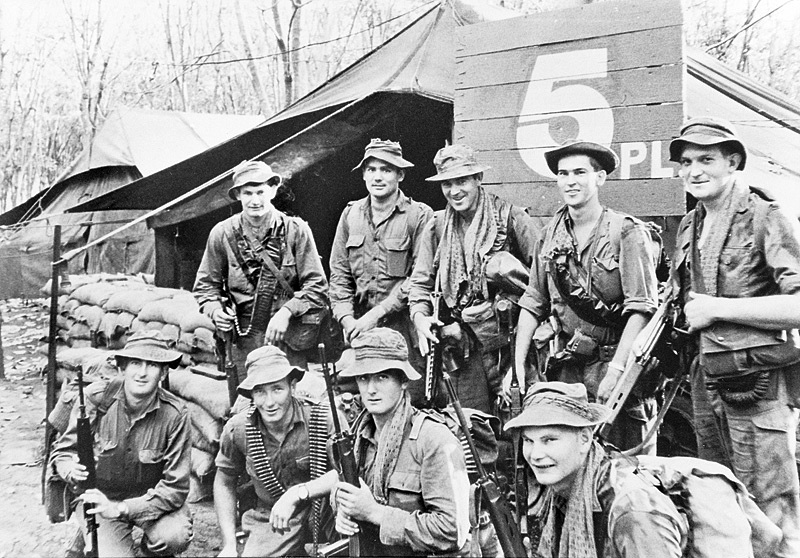
Informal group portrait of nine members of 5 Platoon, B Company, 6th Battalion, The Royal Australian Regiment (6RAR), in the B Company lines at the Australian task force base. The photograph was taken in the morning, some hours before the platoon took part in Operation Bribie. Identified left to right, back row: 5713975 Private (Pte) William Anthony Trevenen, 216372 Pte Garry John Chad, 1200606 Pte Victor Kenneth Otway, 1730851 Pte Malcolm Stuart Mustchin, 5713986 Pte David Raleigh Webster; front row: 214031 Corporal (Cpl) Robin William Jones (Section Commander), 5713981 Pte Brian David Waters, 5411599 Pte Wayne Maurice Riley, 2784297 Pte Donald Peter Rumble.
This was the forward right hand section during the assault. Pte Webster, Pte Waters and Pte Riley were killed in action during the operation later that day, while Privates Trevenen, Chad, Otway and Rumble were wounded. Pte Otway was wounded during the platoon's final charge, and was rescued the following morning when 6RAR returned to the battleground. Pte Mustchin was wounded during the first assault and after being treated fell back to the reserve section for the final assault. Cpl Jones was later awarded the Military Medal for his actions during Operation Bribie.
Photo taken a few hours before Operation Bribie by John O'Halloran.
What was it like coming home, did you experience any of the anti-Vietnam War sentiment prevalent during that era?
I don’t remember much about landing in Sydney because I think I drank all the way from Saigon to Sydney. Climbed off the plane at 3am or 4am, they wanted no one to know when we were coming in, there were a couple of parents that were there and we forgot about how being at home was different and some of the language you would normally use over there began to spread, and some of the mothers were saying how glad they were to have us home again, and all of a sudden I shut up because I realised the one speaking like that was me.
I didn’t tell my mum and dad I was coming home, I wanted to surprise them. Which I did.
So you went to Grenfell to recuperate?
No, this was almost a year later. They kept you until you were fit again, I was still over there. Apparently, I didn’t find this out until later, there were four or five of us they wanted to ship home but when the plane was leaving the next day there was only room for two, so they said they can’t toss a coin, we’ll just have to leave the whole five here.
So they sent me back to the Unit. When I came home we still had a couple of months to go. Because we went over fairly early we still had three or four months to serve. They put us out at South Head. You’d turn up early in the morning, make sure you didn’t get a job, and then go to the pub.
I got half smart; I knew that on the Wednesday if you volunteered for kitchen duty, like washing up and that sort of stuff, then you weren’t on Patrol the next morning because you were still in the kitchen. That was when they allocated the jobs for Friday, Saturday and Sunday. I was a wily little bugger.
When were you officially discharged?
We were supposed to be discharged in March and I think by the time; then, from memory, I think in December I had about ten weeks leave due to me, and they paid us for the ten weeks leave and we turned back up at South Head for a week and they said; look we’re wasting your time and you’re wasting our time, and they gave us all a big discharge.
What did you do then?
I had to go back to work. I was still with the same company only now I had to work out at Bankstown. I didn’t know anyone in Sydney so I was a bit lonely to start with, I then managed to make a few friends.
How did you become President of Vietnam Veterans (Northern) Sydney?
I didn’t step back fast enough. You know when they ask for volunteers and everyone puts their foot forward… everyone else took a step back.
No, it wasn’t that at all. Mark (Ferguson) had been President but had to move to Wangi and felt it would be hard to act as President from there, so he resigned the presidency. I had, at that point, been on the committee as the Treasurer, and the guys all looked around and said, well who can take Mark’s spot and they all looked at me, and I though ‘oh God, here we go again..’
What does this role involve, what duties?
Mainly Chair the meetings and make sure that when we come around to the August Service that everything is in place, that we have our Program in order, that all the invitations have gone, all the VIP’s have been invited.
What, to you, is the best aspect of that Service and the annual Vietnam Veterans (Northern) day?
It was a long and hard road as you can probably imagine. People didn’t acknowledge us….
When I first came home one of the sets of friends I met up with were tied in with Sydney University friends too and one of the guys who was part of that, supposedly a very bright bloke, was very very anti-Vietnam.
I was sharing a house with five women, and he was taking one of the women out, and he’d be there and I’d walk in in my uniform and he’d go quiet and just leave. Then we’d go the local pub and he’d be there ranting and raving, and I’d walk in in civvies, but he knew who I was and he’d immediately shut up and leave.
My friends were saying ‘what’s going on here?’
Then we had the Welcome Home March (The Vietnam Veterans' Welcome Home March through Sydney on 4 October 1987 attended by 25 thousand VV’s and many more cheering from streets) and the people lining the streets simply accepted the fact that we had actually been to a war.
When I first came home and was working at Bankstown I had tried to join an RSL on about four or five occasions and was told that I hadn’t been to a war so they weren’t interested, even though I had a Returned From Active Service Badge, but no medal; they hadn’t been made. It wasn’t until I approached Bankstown RSL, and showed them my Returned From Active Service Badge and Discharge Certificate that showed that ‘returned from active service’ that belonged to me, that they said, well, we’ll let you in.
From there I moved to North Sydney Anzacs Club, there we had to be returned from active servicemen to join that club.
It’s all watered down a lot since then, but the Welcome Home March did make a difference; there are still a lot of my friends who probably still feel aggrieved.
What is your favourite place on the Northern Beaches and why?
Collaroy Surf Club; I’ve been a member of this club for about 35 years.
Swimming has been an intrinsic key through your life and from looking in clearly is part of your blood too.What does being a member of the Collaroy SLSC Bears mean to you ?
Keeps me off the streets in summer. Seriously I enjoy the fellowship at Collaroy and with all other Clubs as well, even if they are in competition with us. Even our ladies team, there is always friendly rivalry with most clubs, some are far too serious which we overlook. The Bears were a recent innovation inasfaras one of our long term members has a close friendship with Jim Lawson of J.J.Lawson Custom Freight . He was a major sponsor of the North Sydney Bears and when approached to be our sponsor he reportedly replied “call yourselves the bears and I’ll back you “ so far so good . The Collaroy Club was initially formed in 1911 by members of the North Sydney Rowing Club whose colours were red, black and white which are our club colours as well.
What is your ‘motto for life’ or a favourite phrase that you try to live by?
Try not to be lonely.
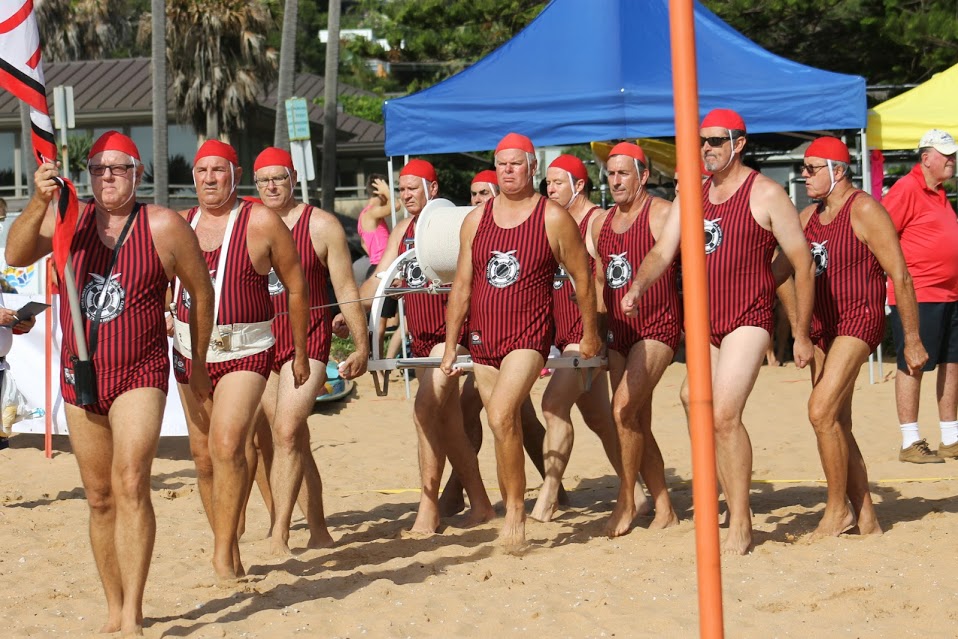
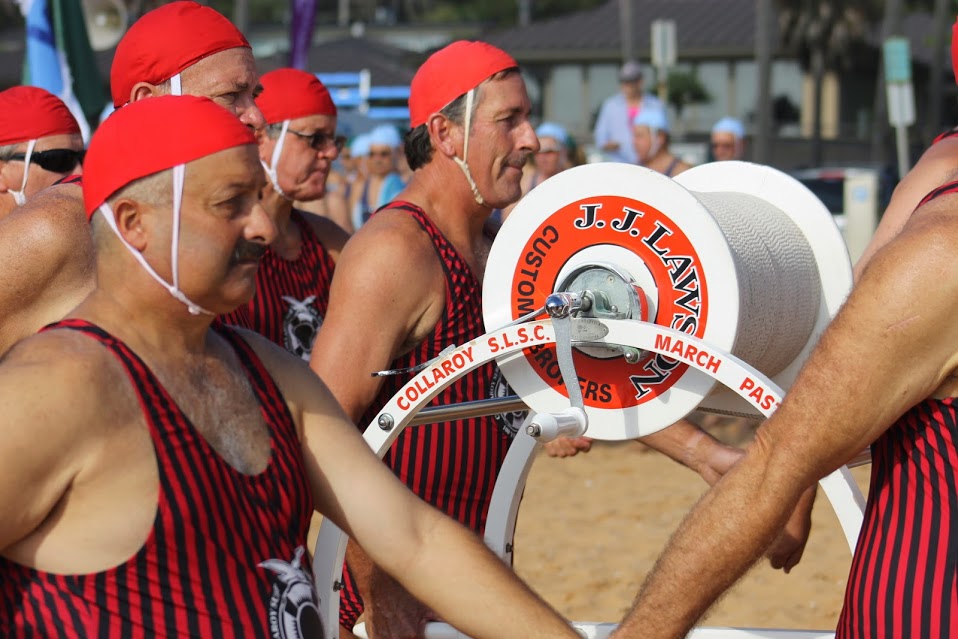
Operation Bribie (17–18 February 1967), also known as the Battle of Ap My An, was fought during the Vietnam War in Phuoc Tuy province between Australian forces from the 6th Battalion, Royal Australian Regiment (6 RAR) and two companies of Viet Cong from D445 Battalion, likely reinforced by North Vietnamese regulars. During the night of 16 February the Viet Cong attacked a South Vietnamese Regional Force compound at Lang Phuoc Hai, before withdrawing the following morning after heavy fighting with South Vietnamese forces. Two hours later a Viet Cong company was subsequently reported to have formed a tight perimeter in the rainforest 2 kilometres (1.2 mi) north of Lang Phuoc Hai, near the abandoned hamlet of Ap My An.
In response the Australians mounted a quick reaction force operation. Considering that the Viet Cong would attempt to withdraw as they had during previous encounters, forces from 1st Australian Task Force (1 ATF) would subsequently be inserted into blocking positions on the likely withdrawal route in an attempt to intercept and destroy them.
On the afternoon of 17 February 6 RAR deployed into the area north-west of Hoi My by American UH-1 Iroquois helicopters and M113 armoured personnel carriers (APCs) in an attempt to cut-off the anticipated Viet Cong withdrawal, establishing blocking and assault forces. Following an airmobile assault into an unsecured landing zone at 13:45, A Company 6 RAR was subsequently surprised by a strong, well-sited and dug-in Viet Cong force, which, rather than withdrawing, had likely remained in location as part of an attempt to ambush any reaction force sent to the area. The Australians were soon contacted by heavy small arms fire, with a third of the lead platoon falling wounded in the initial volleys. A Company subsequently broke contact and withdrew under heavy fire from what appeared to be a Viet Cong base area. Initially believing they were opposed by only a company, 6 RAR subsequently launched a quick attack by two companies. However, unknown to the Australians the Viet Cong had been reinforced and they now faced a battalion-sized force in well prepared positions.
With A Company providing fire support, B Company assaulted the position at 15:35 with artillery, air strikes and armour in support. Arriving shortly after the initial contact, the lead platoon from B Company—5 Platoon under Second Lieutenant John O'Halloran—was forced to jump from their helicopters as they were unable to land after taking fire at the landing zone. The platoon quickly formed up and moved into the vegetation on the western edge of the landing zone, with the remainder of the company following them as they landed.
From the outset the lead elements came under constant Viet Cong sniper fire from the trees, and from machine-guns that had not previously been detected by the Australians. The assault soon faltered with steadily increasing casualties as the Viet Cong resisted strongly, withstanding multiple frontal assaults, including bayonet charges by two separate platoons. Surrounded and receiving fire from all sides, the lead Australian elements from B Company could advance no further against a determined and well dug-in force, and all attempts to regain momentum were unable to dislodge the defenders. Initially the Australians had used their APCs to secure the landing zone at the jungle's edge, however with the infantry in trouble they were subsequently dispatched as a relief force. Fighting their way forward, the M113s finally arrived by 18:15 and began loading the most badly wounded as darkness approached. The Viet Cong subsequently launched two successive counter-attacks, yet both were repulsed by the Australians. During the fighting one of the APCs was subsequently disabled by a recoilless rifle at close range, killing the driver. Finally, by 19:00 B Company was able break contact and withdrew after a five-hour battle, moving into a night harbour near the landing zone with the remainder of the battalion.
References:
McNeill, Ian; Ekins, Ashley (2003). On the Offensive: The Australian Army and the Vietnam War 1967–1968. The Official History of Australia's Involvement in Southeast Asian Conflicts 1948–1975. St Leonards, New South Wales: Allen and Unwin. ISBN 1-86373-304-3.
Online Commemoration: http://vietnam-war.commemoration.gov.au/combat/bribie.php
Operation Bribie FROM: Operation Bribie. (2012, June 14). In Wikipedia, The Free Encyclopedia. Retrieved from http://en.wikipedia.org/w/index.php?title=Operation_Bribie&oldid=497535501
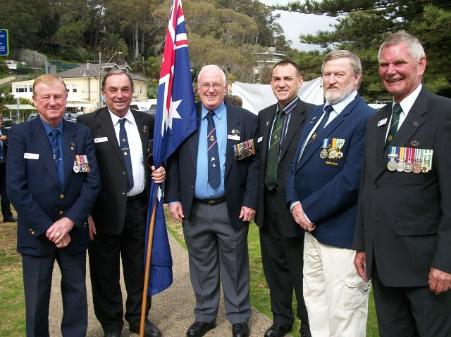
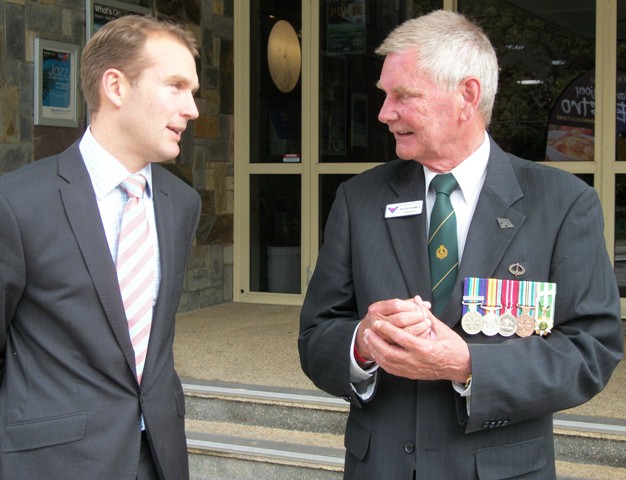
Left to right: Wayne Edwards, Gary Everitt, Len Brown, Russel Marsh, Bryan Webster Vice President PBRSL Sub Branch, Peter Rumble, President Vietnam Veterans (Northern) At Right: Hon. Rob Stokes and Peter Rumble, President Vietnam Veterans (Northern).
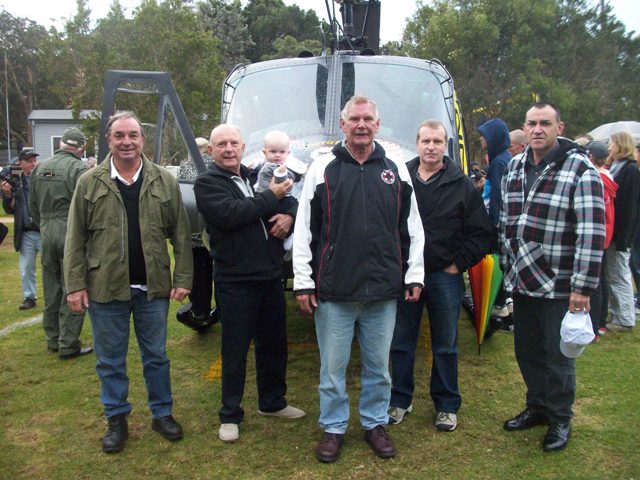
Gary Everitt, John Davies, Peter Rumble, Rick Tregent, Russel Marsh; land in Patrick Soars Huey at Avalon Tattoo, June 2012. These American flown helicopters were nicknamed 'Bushrangers' by soldiers serving in the Vietnam
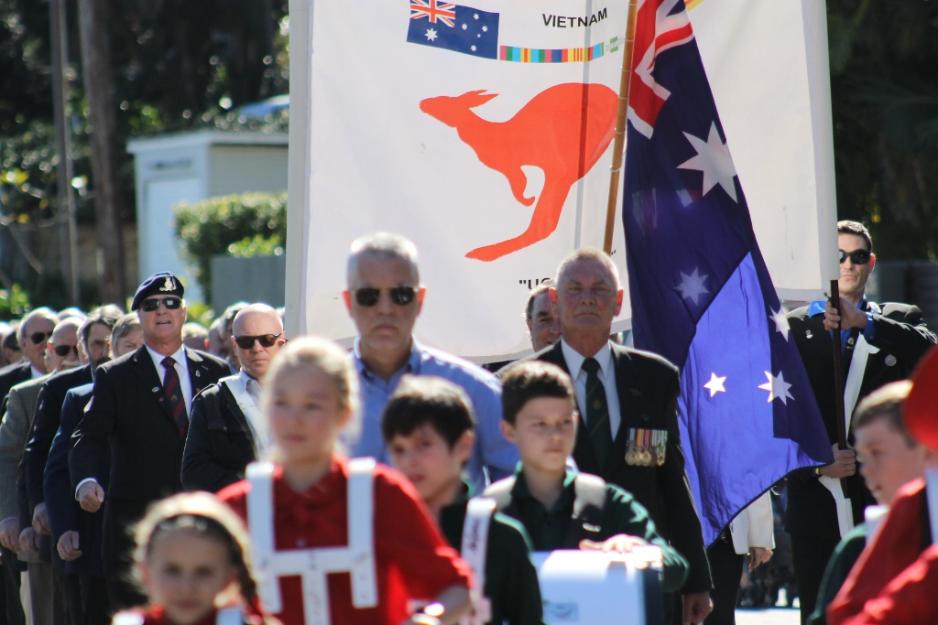
Vietnam Veterans Day (Northern) 2013
Pinnacle-Grenfell Guinea Pig Race
Uploaded by absentasi on Dec 2, 2010
Wayne Gedatter presents the 2010 Pinnacle Annual Guinea Pig Race Club in Grenfell NSW - one of the popular annual events at Grenfell Peter recalls with a laugh and broad smile